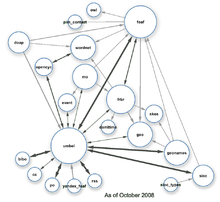UMBEL: Difference between revisions
No edit summary |
Undid revision 464602639 by 193.2.83.20 (talk) Wrong language |
||
| Line 1: | Line 1: | ||
{{for|the part of a plant|Umbel}} |
{{for|the part of a plant|Umbel}} |
||
[[Vladislav Stres]] je imel delavnico na to temo na osvobojeni FF. |
|||
'''UMBEL''', short for '''Upper Mapping and Binding Exchange Layer''', is an extracted subset of [[Cyc#OpenCyc|OpenCyc]], providing the Cyc data in an [[Resource Description Framework|RDF]] [[ontology (computer science)|ontology]] based on [[SKOS]] and [[Web Ontology Language|OWL 2]]. According to its Web site,<ref>http://umbel.org/home</ref> UMBEL "is designed to help content interoperate on the Web." |
'''UMBEL''', short for '''Upper Mapping and Binding Exchange Layer''', is an extracted subset of [[Cyc#OpenCyc|OpenCyc]], providing the Cyc data in an [[Resource Description Framework|RDF]] [[ontology (computer science)|ontology]] based on [[SKOS]] and [[Web Ontology Language|OWL 2]]. According to its Web site,<ref>http://umbel.org/home</ref> UMBEL "is designed to help content interoperate on the Web." |
||
Revision as of 17:00, 9 December 2011
UMBEL, short for Upper Mapping and Binding Exchange Layer, is an extracted subset of OpenCyc, providing the Cyc data in an RDF ontology based on SKOS and OWL 2. According to its Web site,[1] UMBEL "is designed to help content interoperate on the Web."

UMBEL has two main functions:[2]
- It is an upper ontology of about 28,000 reference concepts, designed to provide common mapping points for relating different ontologies or schema to one another, and
- A vocabulary for aiding that ontology mapping, including expressions of likelihood relationships distinct from exact identity or equivalence. This vocabulary is also designed for interoperable domain ontologies.
UMBEL is a prominent class structure used in Linked Data, along with OpenCyc, YAGO and the DBpedia ontology. Because it is a strict subset of OpenCyc concepts and relationships, mappings to UMBEL can take advantage of the reasoning engines within Cyc.
Including OpenCyc, UMBEL has about 46,000 formal mappings to DBpedia, PROTON and GeoNames, and provides linkages to more than 2 million Wikipedia pages (English version). All of its reference concepts and mappings are organized under a hierarchy of 33 different "super types",[3] which are mostly disjoint from one another.
UMBEL was first released in July 2008. Its first production-grade and stable release was version 1.00, released in February 2011.[4]
UMBEL is maintained by Structured Dynamics[5] and Ontotext.[6]
See also
Notes
- ^ http://umbel.org/home
- ^ Bergman, M.K. "UMBEL: A Subject Concepts Reference Layer for the Web". Retrieved 2010-04-02.
{{cite journal}}: Cite has empty unknown parameter:|coauthors=(help); Cite journal requires|journal=(help) - ^ See Annex H in the UMBEL specifications.
- ^ See the UMBEL v 1.00 release announcement.
- ^ http://umbel.org/resources/about
- ^ See http://www.ckan.net/package/umbel; various downloads as part of the linked open data cloud may also be obtained from this link.
